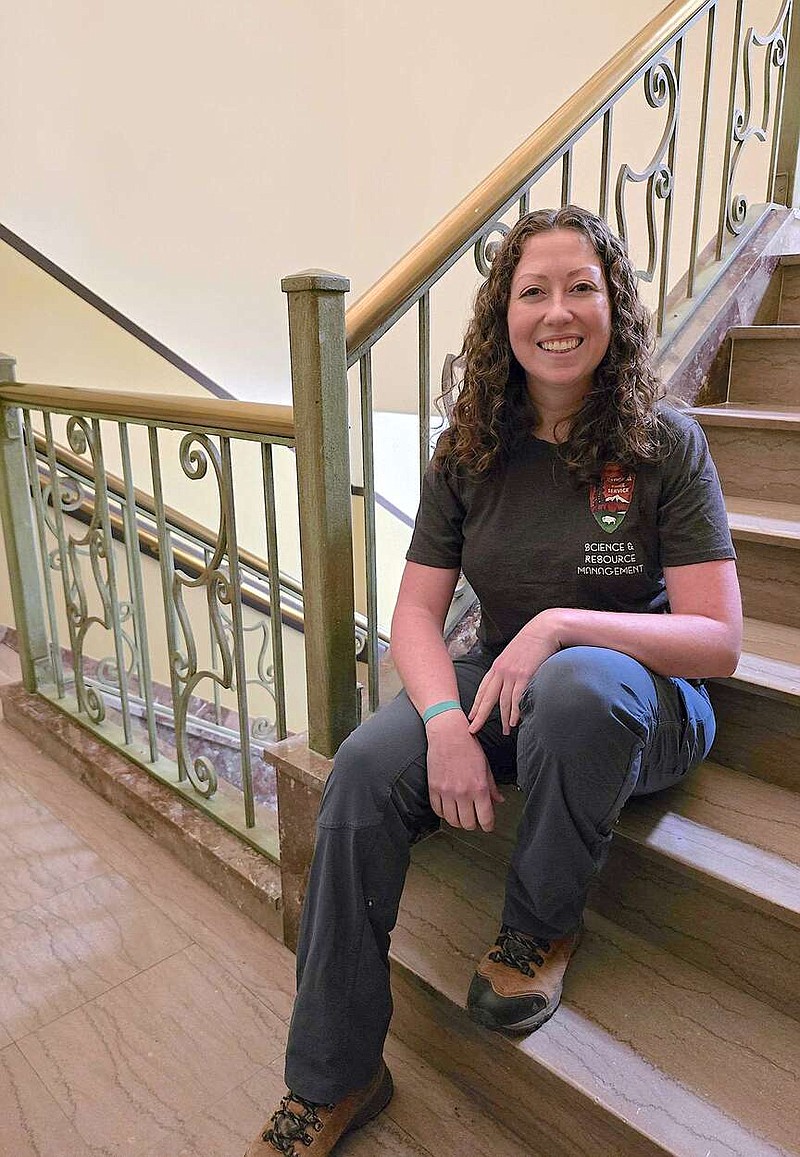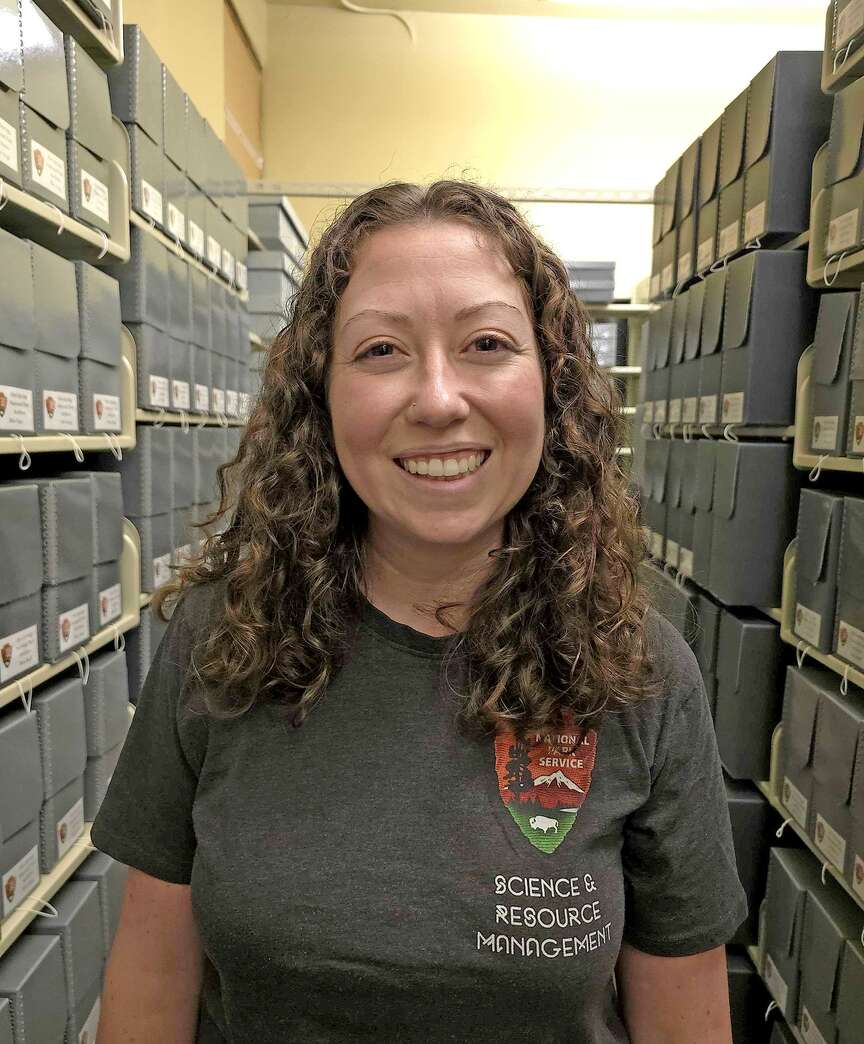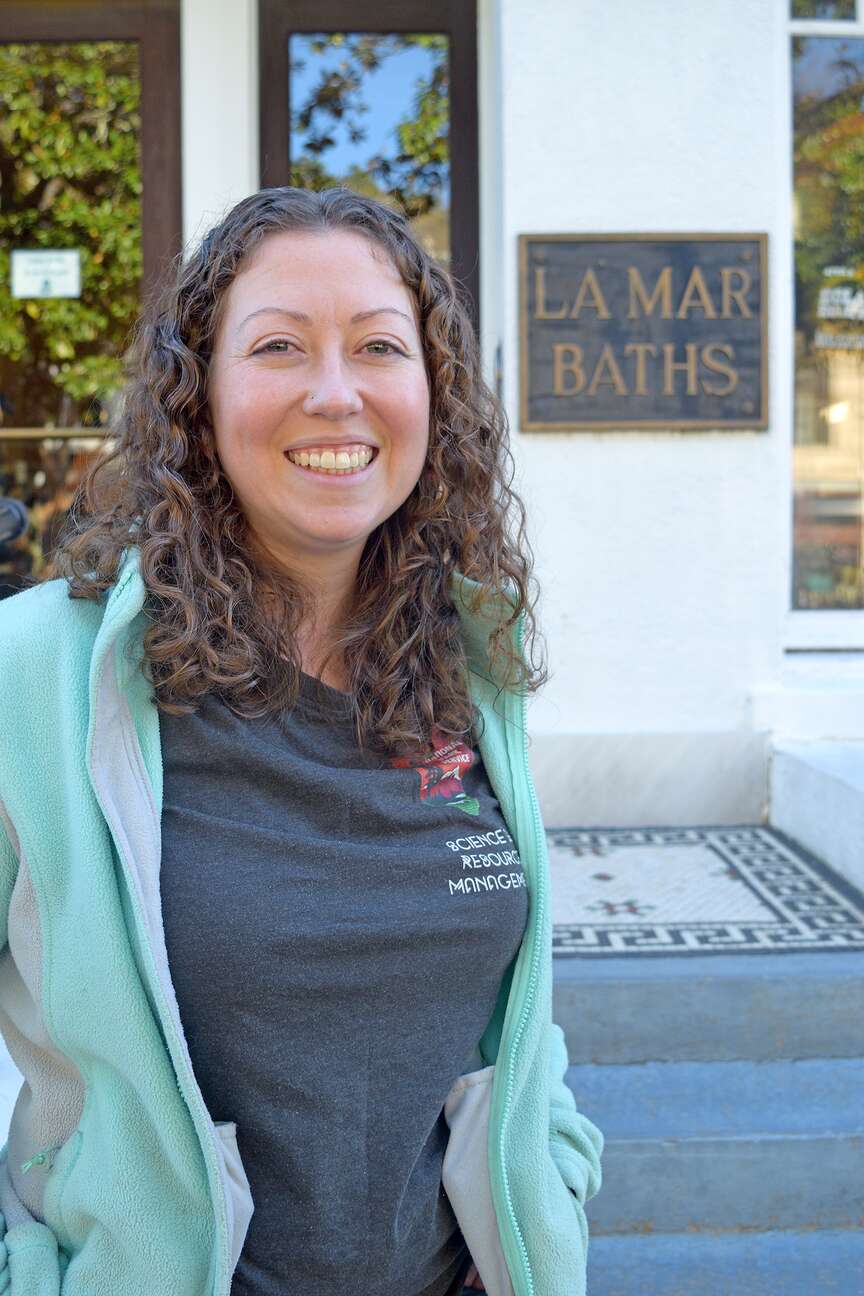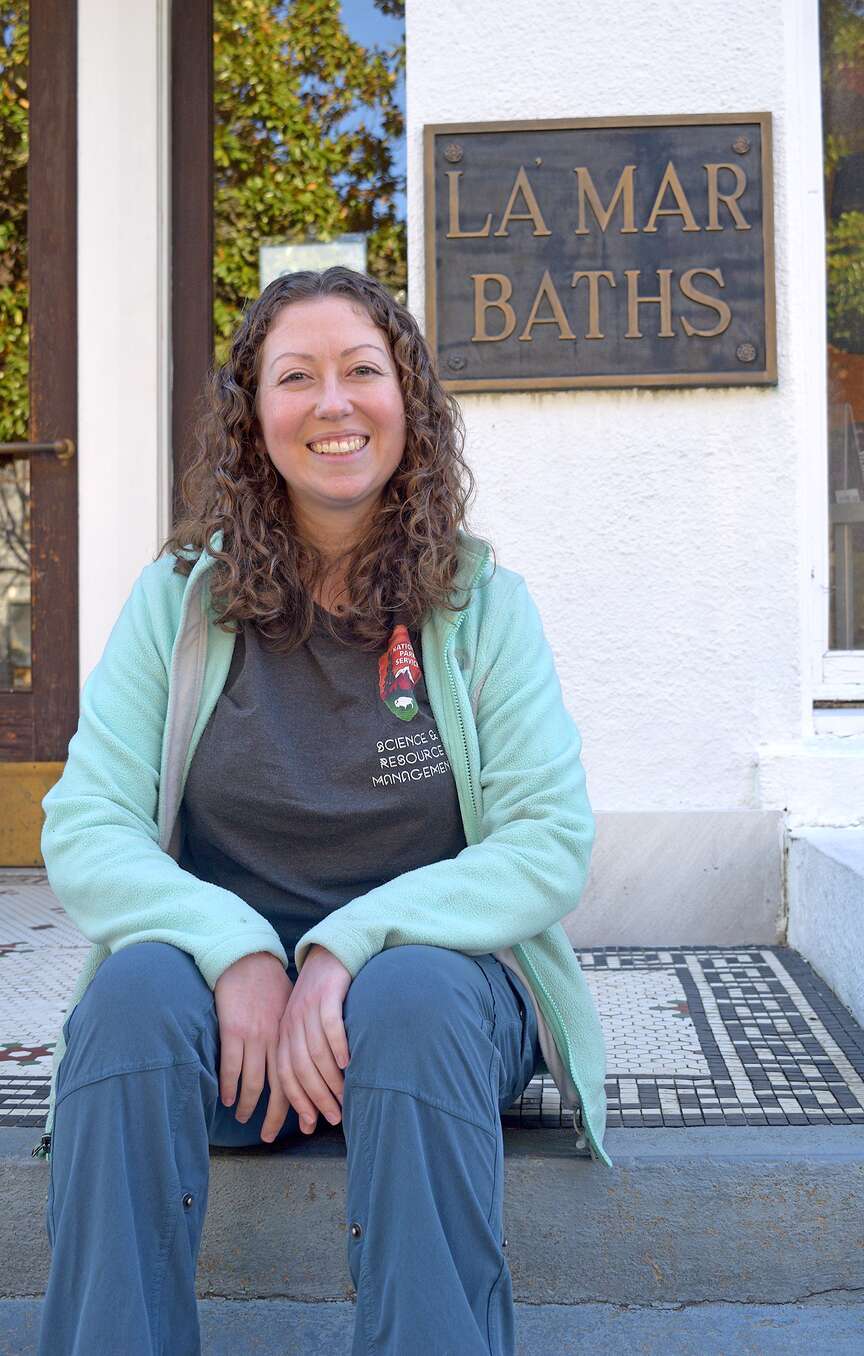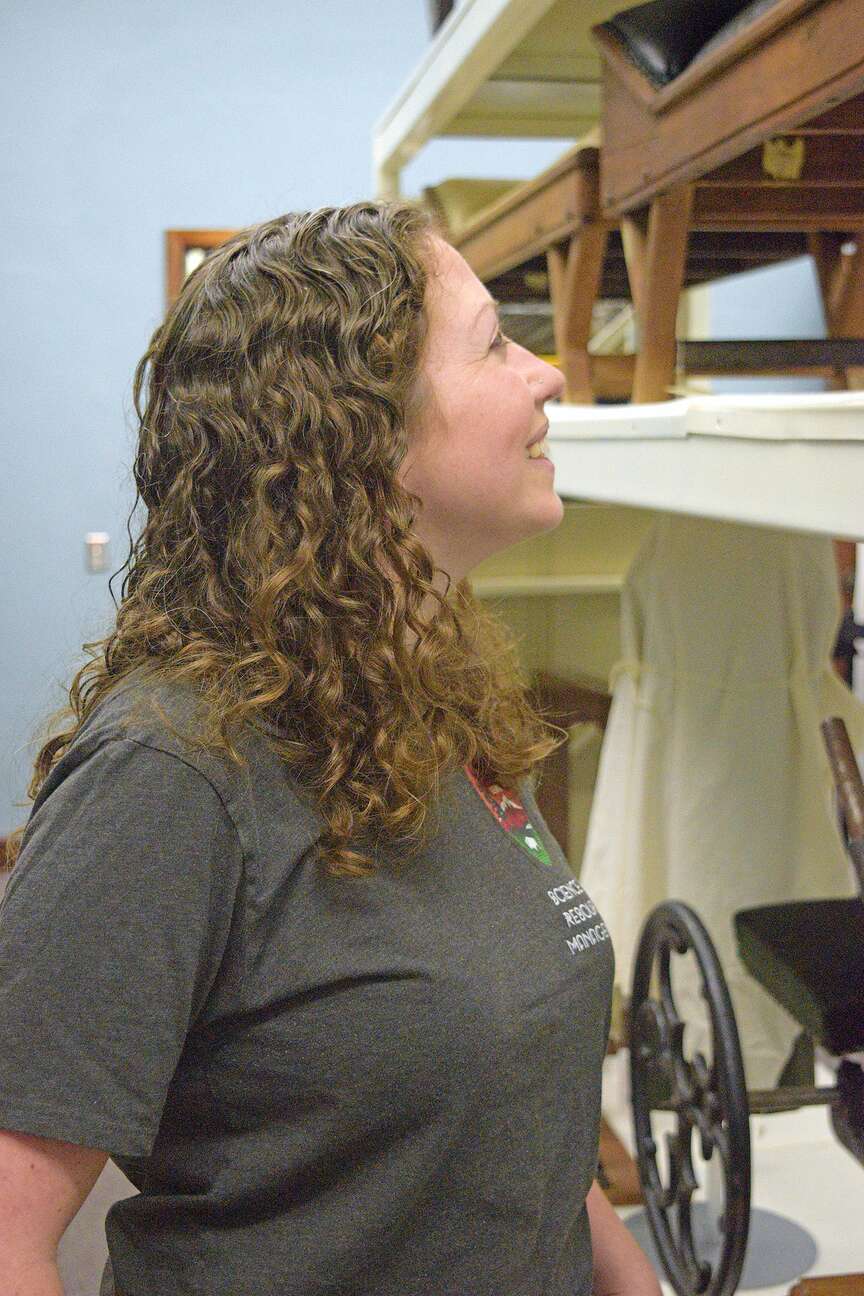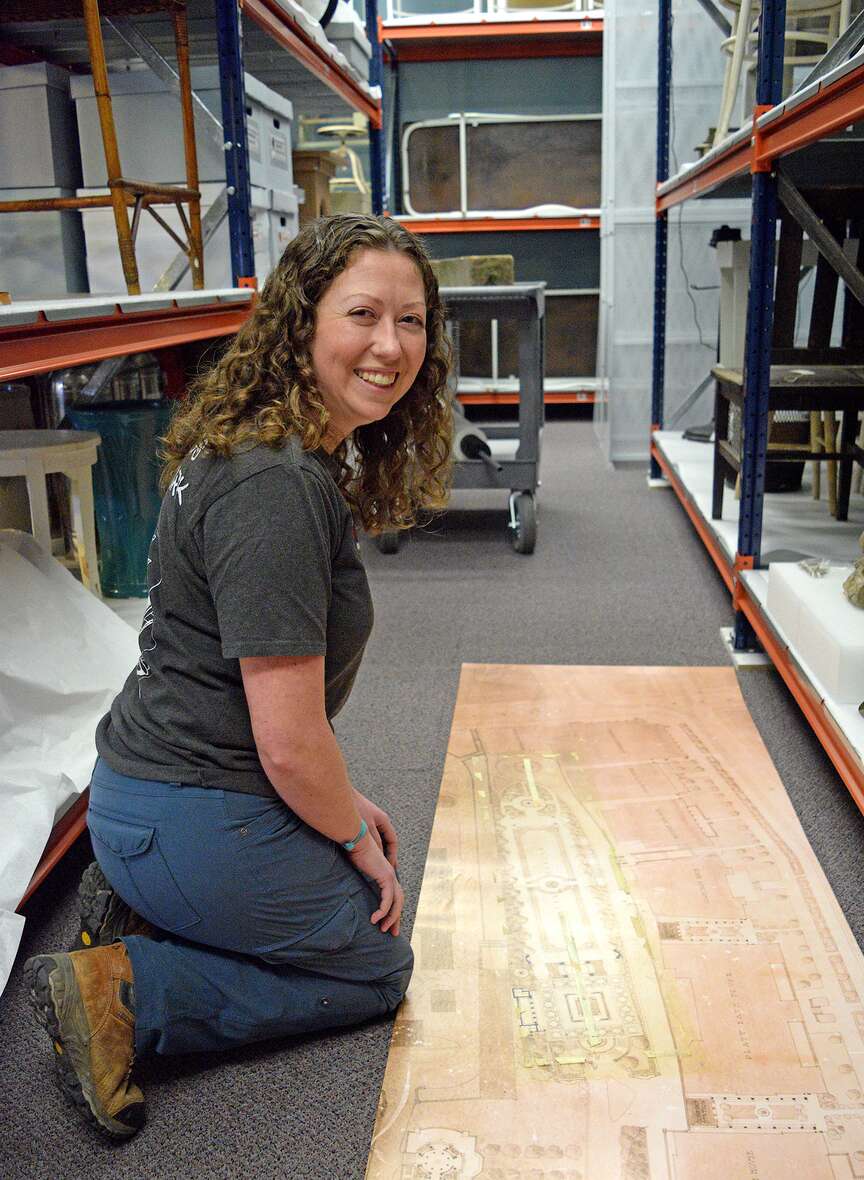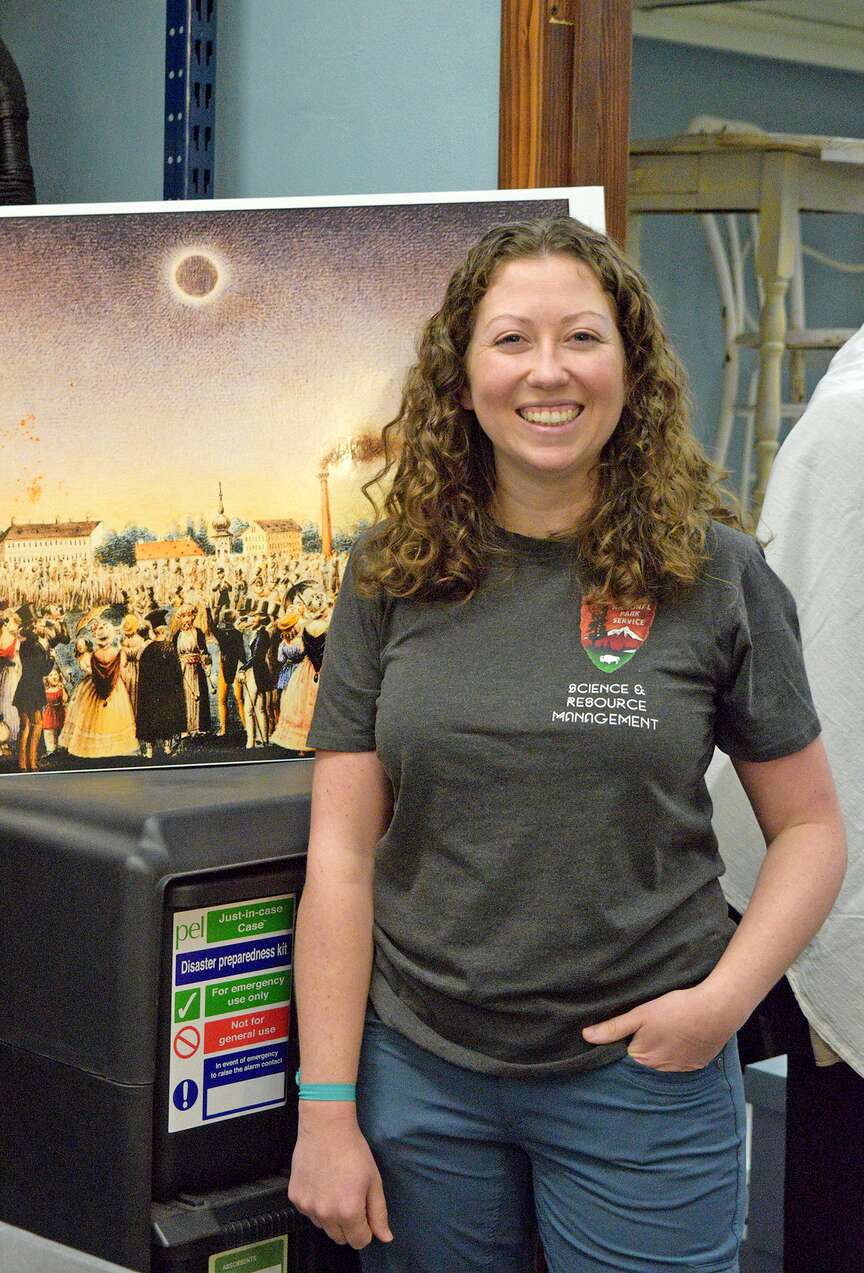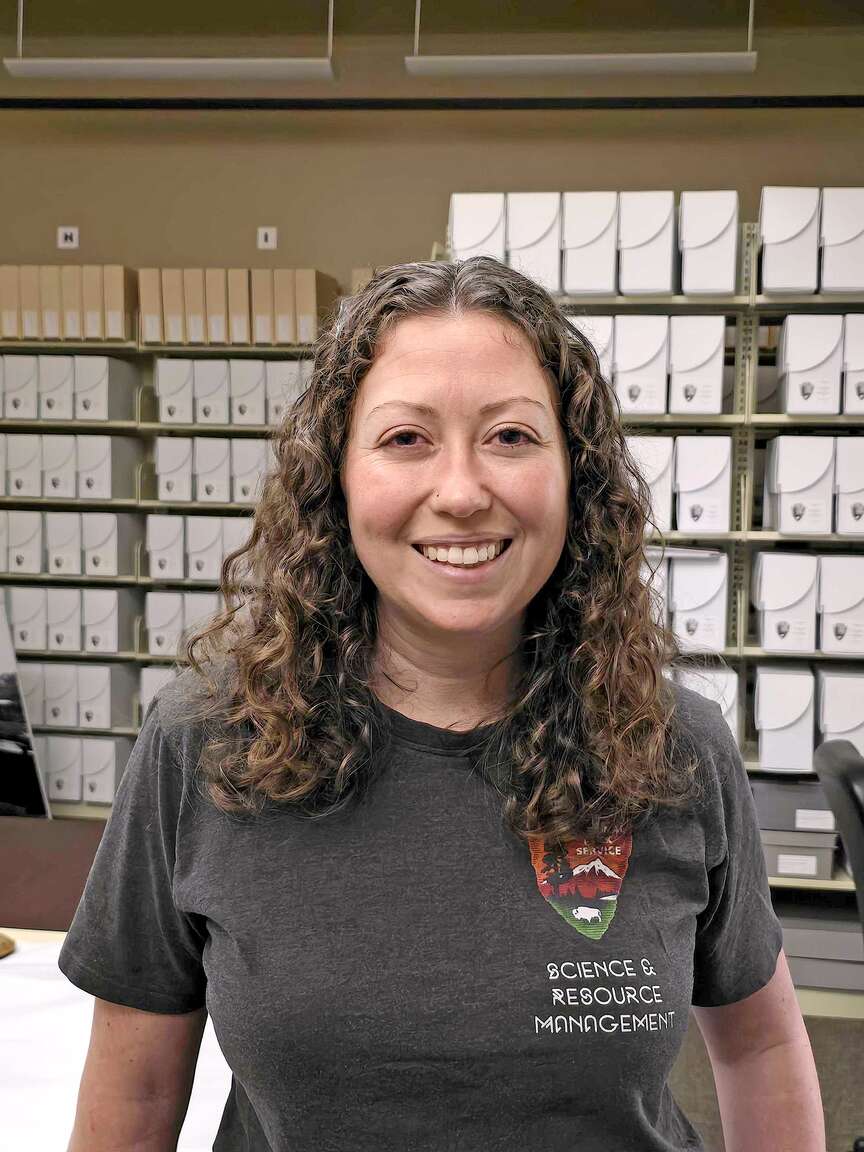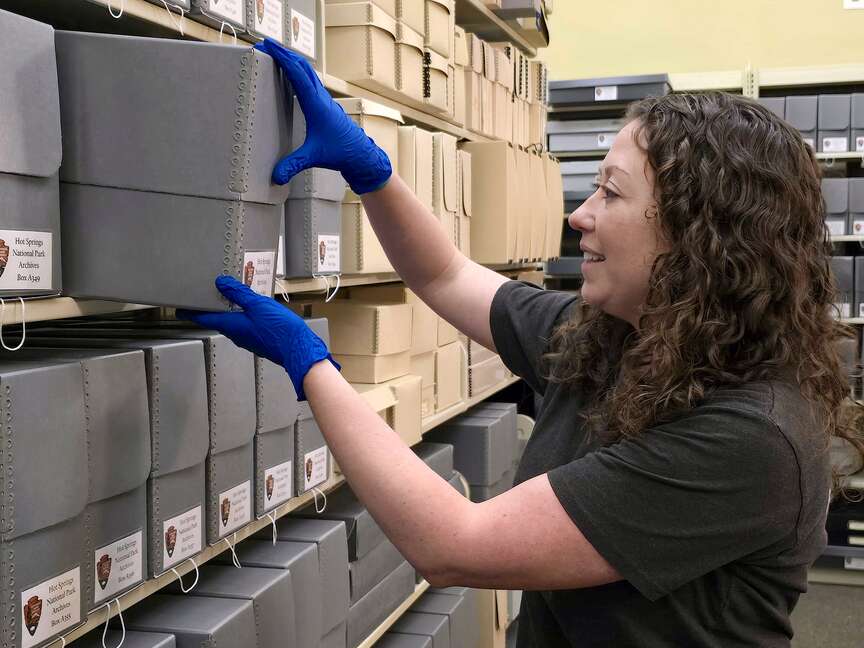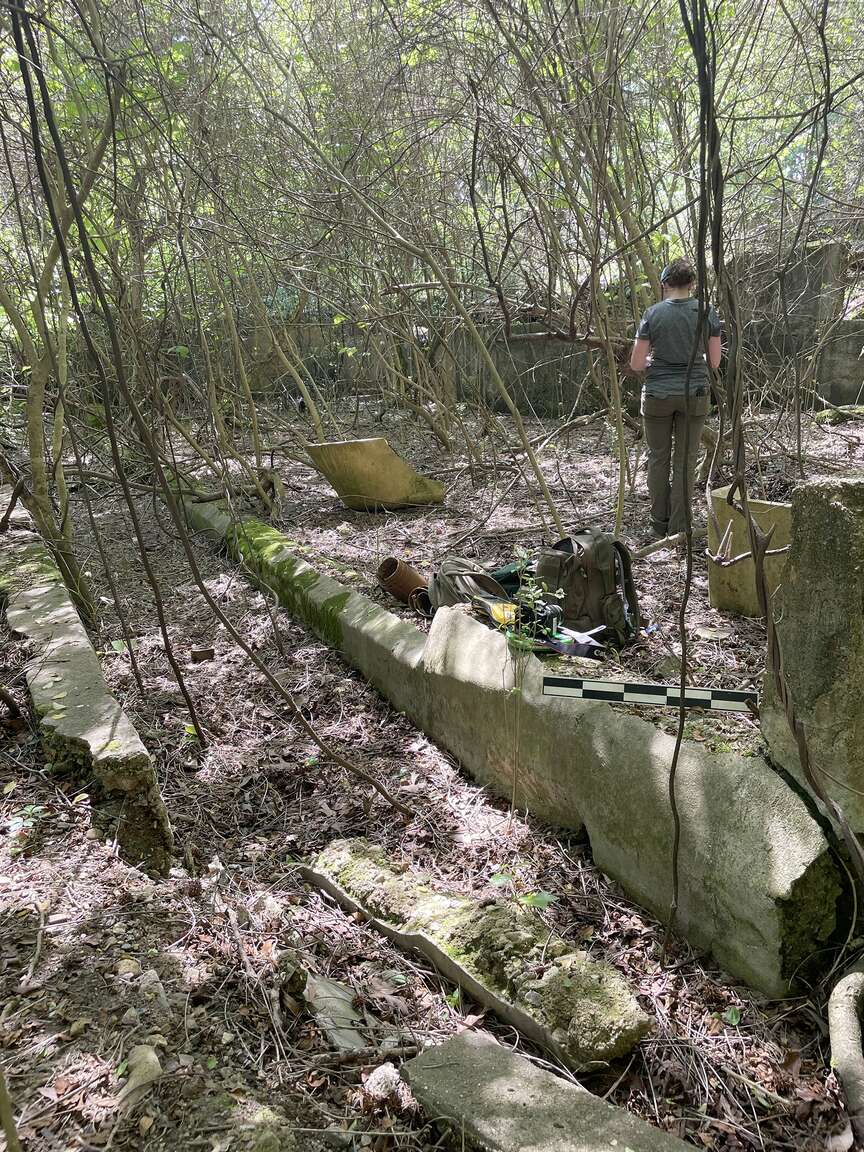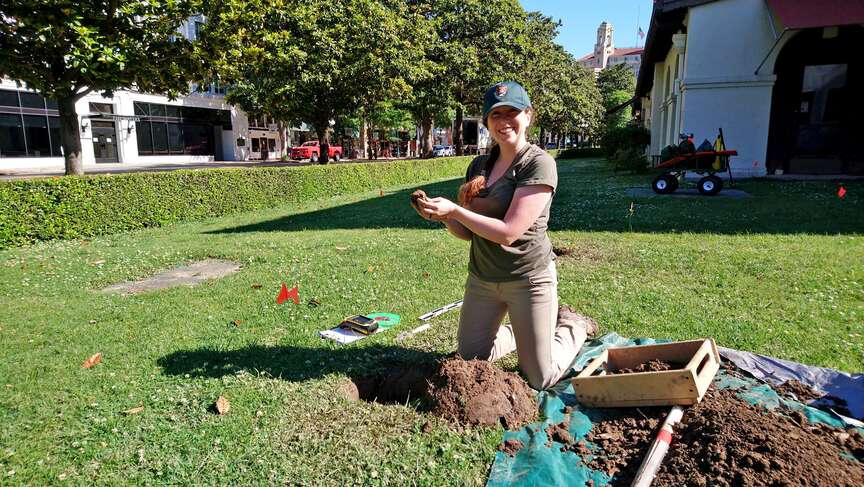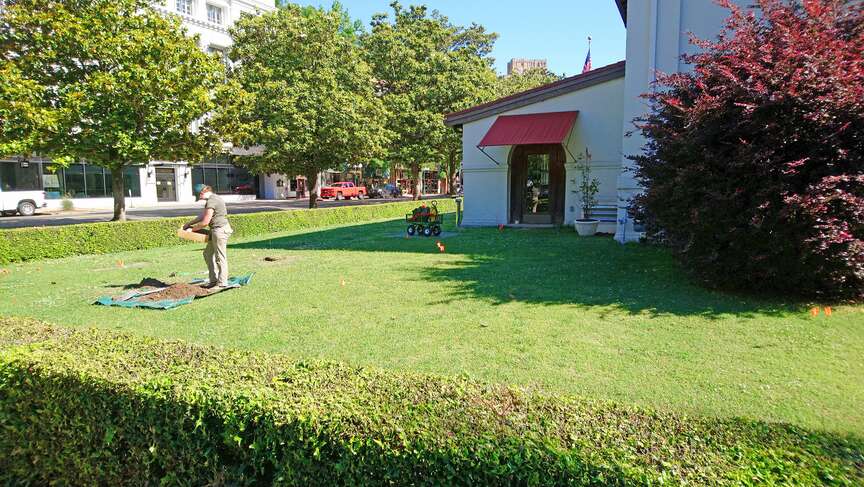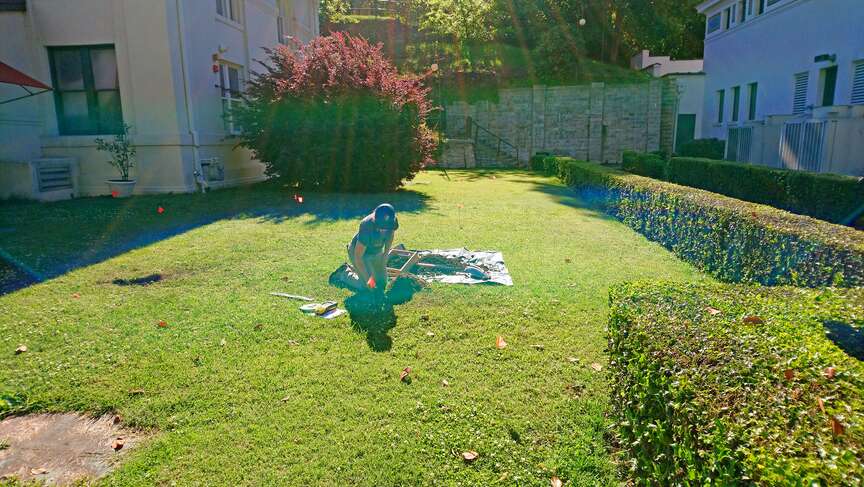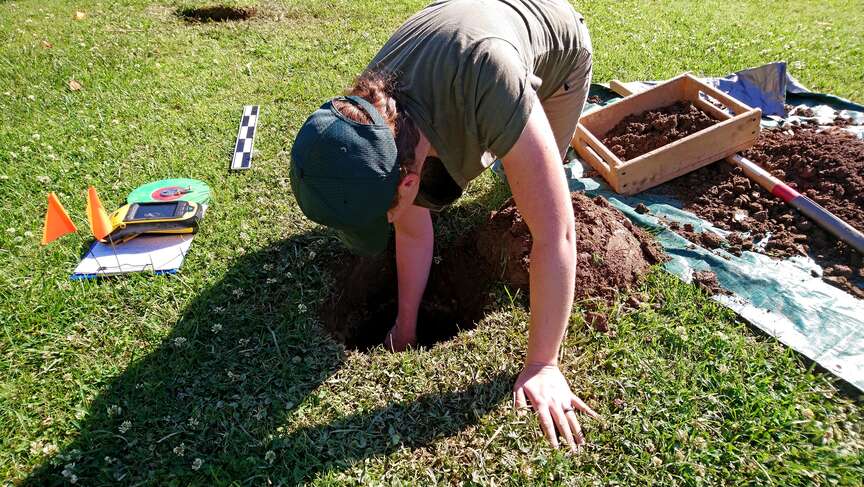Story by James Leigh
Photos by Donald Cross
A young Victoria Jenkins was fascinated with history, reading about ancient civilizations, and was able to turn that childhood passion into a career as an archaeologist.
Now, Victoria Reichard, a transplant from Virginia who has worked on archaeological sites around the world, is the staff archaeologist for Hot Springs National Park.
"I was one of those kids who never outgrew their childhood passion," she said. "So I was the one who always had the books on mummies and ancient Rome and ancient Greece, and all of that was just so fascinating for me. The other kind of inspiration there was my grandma. She traveled all over the place and always had great stories about everything. She also was very passionate about history and loved all of that, so I kind of picked up some of that from her."
While most people tend to confuse archaeology with paleontology, Reichard said the two are similar but different historical studies.
"It's defined as the study of material culture, with material culture being anything made or used by humans, so that could be anything as recent as today," she said of archaeology. "I mean, technically the trash I threw out today could be considered archaeology. For us in the U.S. as federal government employees, we consider anything 50 years or older to be archaeology. That way, I'm not out documenting people's trash. It would take a lot of time and a lot of effort, cause a lot of red tape for no reason."
Reichard said when she went to college at the University of Virginia, she knew exactly what she wanted to do, which while less common among most students is "a little more common" among those interested in the field.
"It's something you have to be passionate about, otherwise you're not going to do it," she said. "And then went to grad school (at Wharton). From there, I wasn't entirely sure what I wanted to do. I thought I wanted to go into the academic side of things, which would require me to continue on and get a doctorate, but honestly, I was just burnt out after a master's. I went straight through, and I was done for a little while."
She started working for a cultural resource management firm, which is "the contracting, private sector side of archaeology."
"I learned a lot," Reichard said. "Got to travel a lot, worked in, I don't know, probably 15 states in those five years, traveling around, doing all kinds of different contracts on pipelines and military bases and Forest Service. ... From there, went into a nonprofit job doing POW/MIA recovery overseas, and then it was kind of time to get a little closer to home, a little more settled."
Reichard said that in some aspects, the field is as male-dominated as it appears in popular culture, but in the academic and government side of things, "if it's not equal, it may actually be more women" than men. Despite that, there is still an inordinate amount of sexism.
"There have been a lot of big shifts, even since I started working in this field, but there's still a lot of sexism," she said. "A lot of it is the work environments you're working in. ... That being said, there's also a lot of really great, both men and women, but I've got to give credit to some of the guys that I worked with because they were really great about having my back and also making sure that I had the space to be an equal, if that makes sense. Not that I'm not stubborn and bullheaded enough to create that space, but I appreciated not having to create that space."
Dealing with sexism is "frustrating," Reichard said.
"You get comments about how you don't belong there, how you're incapable of doing your job, things like that," she said. "And it's like, 'No, I'm very much capable of doing what I'm doing. I do it very well,' all modesty aside. At times, it's very discouraging, and you learn very quickly how to have a thick skin.
"You get in some of those settings, men can think they can bully you out of doing your jobs. People trying to push you around like 'Well, you don't really need to do that, so you? We can just blast through that.' It's like, 'No. No, we're doing this the right way.' You definitely have to learn how to stand up for yourself."
Reichard said that you have "to find your backbone" when it comes to dealing with things like sexism in the workplace.
"I say find because I think everyone has one; it's just a matter of coming up with where it is," she said. "And then at times, you get some impostor syndrome. 'Do I actually belong here? Am I actually good at this, or am I here because somebody thought I was attractive?' And that's not great for anyone or anything. So (it's) discouraging, but again, all of that is changing. I'm very hopeful for the future of this field."
Some things in archaeology have changed significantly over the years, but most basic things remain the same. Reichard said her role as an archaeologist has changed since her first job in the field.
"I would say at the base, methodologies stay similar," she said. "Obviously, technology evolves. We're using better GPS units. We're using better equipment, things like that. When I started, I was a low-level field tech, so I was doing whatever somebody else told me to do. Now I end up doing a lot more report writing, a lot more of the planning side of things. I do the fieldwork as well -- I'm a one-woman show here -- but there's a lot more that goes into it than just getting out with a shovel and digging a hole where somebody says dig your hole there."
Reichard said that while the laws and regulations involved with archaeology in the public and private sector are the same, the biggest difference is the amount of time she can dedicate to a site.
"We still have to do all of that compliance work, but I would say the biggest difference here is the amount of time that I have to do things," she said. "I can do a better job, frankly. I'm not on such a time crunch that I have to rush through it.
"And then also, I have a little bit more time when there aren't all those projects going on to kind of get out into some areas of the park, figure out what's there and it's not project-driven. It's just let's-find-out-what's-here-driven, which still does come from federal regulations. We're mandated to do that, but it's just a little more free. I get to pick what area I want to work on. If there's something that comes up that's really interesting to me, I have the freedom to kind of chase that."
The process of finding a site to investigate comes from research and tips she gets from others, Reichard said.
"It's trying to find that balance between covering ground and doing cool things," she said of deciding what avenues to pursue. "But I mean, every now and then we'll get a really great lead from like high-level research, or somebody will call and say, 'Hey, by the way, when I was there, 30 years ago, there was this thing over here.' And so we get some good leads that way. So it just kind of depends. Also, sometimes our staff will find something and be like, 'Did you know there's a foundation over here? Do you want to look at it?' So it's lots of fun things."
Reichard said that while there is a wealth of information about some things, she enjoys telling stories about things that might get overlooked.
"Our history books are mostly about rich people, frankly, and that wasn't the majority of the population," she said. "But that doesn't mean that everyone else didn't matter, that their stories didn't matter, that they didn't shape the way that things move the same way as everyone else.
"For example, I got to work on an area where there was a Reconstruction and Jim Crow era African American community here, and it had apparently just been forgotten, at least at the park level. I'm sure people in the community remember, but how are we incorporating their stories into the bigger picture? Or a detention hospital for loose women in World War II here in Hot Springs? But again, forgotten. I'm sure there are people who do remember it, but as part of the big picture story of Hot Springs, how are we incorporating all of those stories and how are we telling the history of this town without excluding 80% of the population?"
With a standard of 50 years or older, Hot Springs National Park has a wealth of places that could be historical sites, but not all sites are equal, Reichard said.
"If you look at, say, the Trinity site versus somebody went out in the woods and camped for two days -- those are not equally important," she said. "So we talk about that as eligibility for ... the National Register of Historic Places. There's a set of criteria, and if something meets those criteria, we say, 'Yes, it is eligible for the National Register,' and that means this is important, we should protect it. We need to actually care about this. Or we say it's not eligible for the National Register, and by that we're saying we've exhausted the research potential here. There's nothing that we really care about. Do what you need to do."
Reichard said sometimes the value of a site is in its educational capability instead of its research potential.
"That's kind of where we landed with Pullman," she said, referencing the old homesite along the Pullman Trail. "We could clean all this up, or we could use this as an educational opportunity to talk about like, 'OK, here's an archaeological site. Here's what we should do with it. Here's what we shouldn't do with it. You're going to see stuff all around you.' And in some ways, it kind of makes the trail more fun when there's an old car down the hill, so value doesn't necessarily have to come out of just the historical value."
Some of the artifacts Reichard discovered during her research included "a 1930s lipstick tube with hula girls on it," but she has enjoyed getting to look into some of the "more worthwhile" sites both at the national park and outside the country.
"I really, really dug into that detention hospital," she said. "That was something that I was in shock that it was not a bigger topic of conversation, so that was probably my favorite project I worked on here. The coolest thing I found elsewhere: I was working in Israel and found and Islamic period ivory spoon that was carved and beautiful and really cool. Working in Ecuador on a Caranqui site, we found the first floor from that specific time period as well as a ceramic pot."
Reichard is passionate about "inspiring the next generation" of archaeologists.
"I think that's a really important thing to do," she said. "And anyone who wants to know more, who wants help figuring out what path they need to take to get there, if they just want to know more about it -- we could probably arrange for them to come in the field with me for a day. Whatever I can do to help people figure out if this is something they want to do, I'm more than happy to help with."
Often children have an innate interest in archaeology, paleontology or other scientific studies that they lose over time, and Reichard encourages them to keep that interest alive.
"I would say to keep chasing your passion," she said. "Don't let society tell you what's a good career path because there are a lot of jobs in this. And then also, to get out of some of the standard history books and to find some of the more niche things that maybe you're really interested in. ... Chase your dreams and set your default to 'I can' instead of 'I can't.' You're capable of so much more than you know, and don't let anyone tell you otherwise."
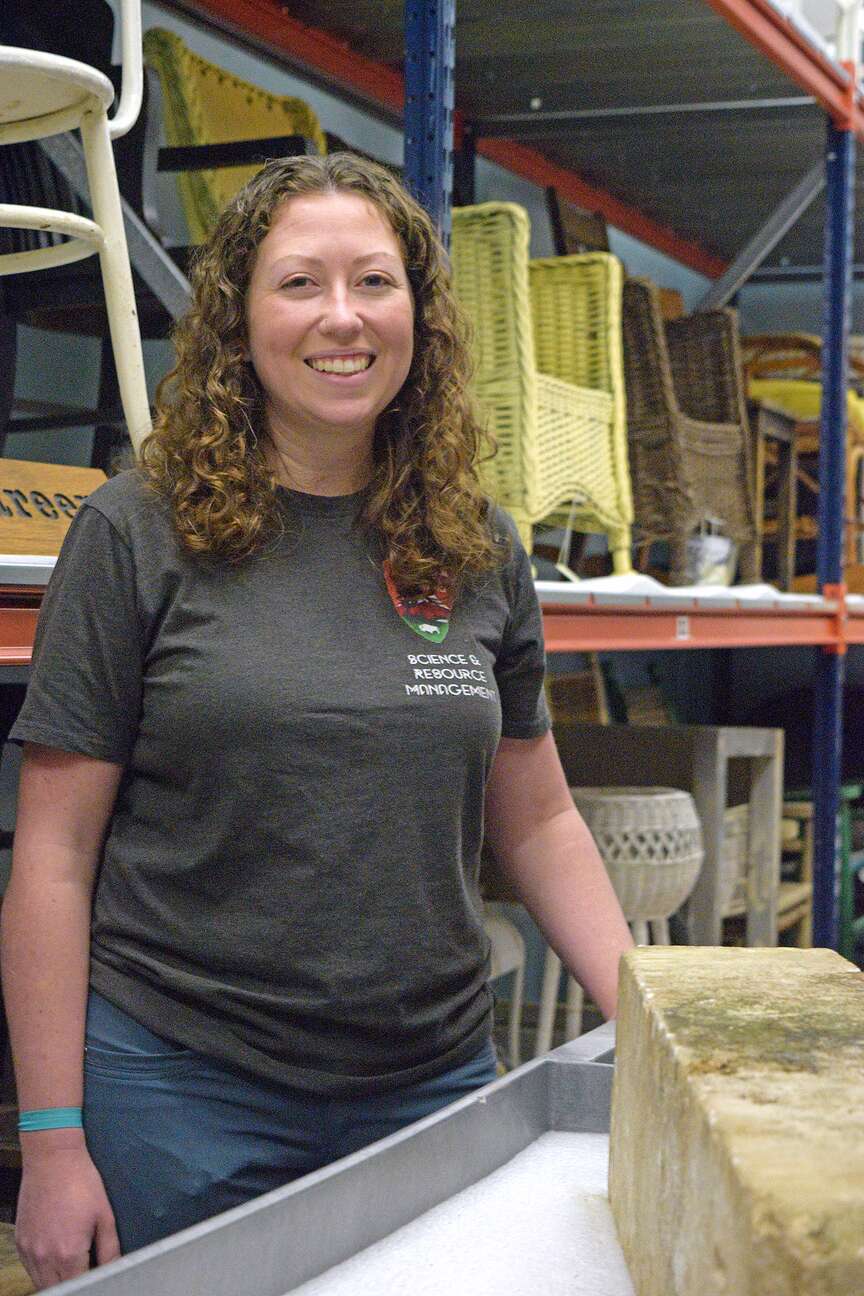 Archaeology is not always about digging up artifacts from hundreds of years ago, a fact that does not escape Hot Springs National Park archaeologist Victoria Reichard. Some of the artifacts the national park have in storage range from wicker furniture to photographs. (The Sentinel-Record/Donald Cross)
Archaeology is not always about digging up artifacts from hundreds of years ago, a fact that does not escape Hot Springs National Park archaeologist Victoria Reichard. Some of the artifacts the national park have in storage range from wicker furniture to photographs. (The Sentinel-Record/Donald Cross)